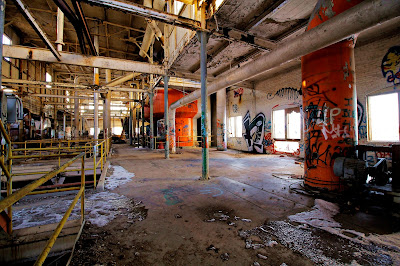The Titan missiles were developed during the Cold War as a show of U.S. military might. The Titan 2B missile based housed three mighty Titan 1 ICBMs. These were one of the first strategic, intercontinental ballistic missiles developed by the United States. Each Titan was 98ft long and weighed in excess of 200,000 pounds. They were two-stage missiles, powered by kerosene(RP-1 fuel) and liquid oxygen and had an effective range of 6,300 miles. They were designed to carry nuclear warheads as a counter to the growing Soviet military threat.
The Titan missile had a relatively short career. The Titan program began in January of 1955 by the Martin Company, parallel with the Atlas ICBM program. The Titan mission was two-fold, first as a back-up should the Atlas program fail, and secondly to be a larger, two-stage missile with a larger payload and longer range that could be used as a booster for space missions. The first successful launch of a Titan missile happened on February 6, 1959, and the final launch happened a short six years later on March 5, 1965.
There were six squadrons deployed throughout five states. Two in Colorado, one in California, one in Idaho, one in Washington and one in South Dakota. Each squadron was deployed in a 3x3 pattern(that is, three bases each equipped with three missiles/silos). Each base had three missiles along with one that would be kept in reserve. This meant that a total of 60 Titan 1 missiles were in operation.
Each base was built entirely underground. The bases included everything the crews and missiles would need for operation and survival. They were built to be able to withstand a nuclear blast(fun fact- even the bathrooms were built to be entirely shock proof!). The major downside to the Titan, was that it was slow to be launched. The missiles would be fueled inside their silo(a 15 minute process in and of itself) and then had to be raised out of the silo for launch. The missiles relied on radio guidance, as full internal guidance had not been perfected at the time. This meant that a precise target had to be located by radar, and then adjustments would be sent to the missile as it was in flight to make sure it stayed on track. The Titan carried an AVCO Mk 4 re-entry vehicle containing a W38 thermonuclear bomb. The bomb had a 3.75 megaton yield and could be fused for air burst or contact burst.
Though deployed in 1961, the Titan 1 had already been eclipsed by both the Atlas ICBM and it's replacement, the Titan 2. The Titan 2 was a bigger and more powerful ICBM that was fueled with storable hypergolic propellants. After a brief period as an operation ICBM, the Titan 1 missiles were decommissioned in 1965. While decommissioned Atlas and later, Titan 2, missiles were recycled and used for space missions, the Titan 1 missiles were simply scrapped.
The Titan 2B missile base was part of the 725th Strategic Missile Squadron. The 725th is currently an inactive unit and was last assigned to the 451st Strategic Missile Wing, stationed at Lowry AFB. The 725th was activated in WWII as a B-24 Liberator heavy bombardment squadron in May of 1943. Deployed in Italy in January of 1944, the squadron entered the war that same month as part of the Fifteenth Air Force. An excerpt from Wikipedia: "The squadron also flew support and interdictory missions and helped to prepare the way for and participated in the invasion of southern France in August 1944. It transported supplies to troops in Italy during September 1944 and supported the final advance of the Allied armies in northern Italy in April 1945." The squadron returned home shortly after and was inactivated on September 26, 1945. The squadron was reactivated in 1961 as a Titan 1 ICBM launch squadron. It was assigned to the 451st Strategic Missile Wing. The squadron would be short lived, however. The Titan 1 missiles were phased out of service in 1964. The squadron was taken off alert status on February 17, 1965. The last missile was shipped out for scrapping on April 15, and the Air Force subsequently inactivated the squadron on June 25, 1965.
Wow. The history to the location is almost as incredible as the location itself. Many times I have thought back on my visits, and every time I fail to find the words to accurately describe the amazingness, vastness and pure darkness that makes up a Titan base. Once you step inside, you completely leave behind the world you knew. There is no light down here. There is no sound down here. I dare you, if you visit, to shut off all your lights at one point and stand motionless. You will be overwhelmed and blown away by the purity of the darkness and absolute silence you find yourself in. I have been three times. Each time I struggle to comprehend and fully appreciate the base. Wandering the maze of tunnels, I cherish the fact that I am able to experience the location and be inside. My mind wanders as I try to imagine what life was like working here. I try to imagine a nuclear missile sitting ready inside one of the enormous silos. I try to imagine the workers running through the corridors to wherever they are headed. This is one of my absolute most favorite places on the earth(or should I say, under). My photos barely do justice to capturing the beautiful black monster that is a Titan missile base.
The generator room. This was the "heart" of the base.
To cap off the post I want to give a quick shout out to another excellent blog, I Love Colorado History. Please check out this blog! Filled with great historic information, fun stories and excellent photos.





































































